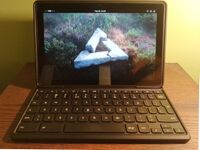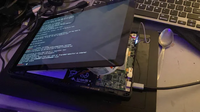Lenovo 10e Chromebook Tablet (google-kodama)
| This page is supplementary to the Google Kukui Chromebook (google-kukui), refer to it before attempting to install postmarketOS. |
 Lenovo 10e running GNOME | |
| Manufacturer | Lenovo |
|---|---|
| Name | 10e Chromebook Tablet |
| Codename | google-kodama |
| Released | 2020 |
| Category | community |
| Pre-built images | yes |
| Original software | ChromeOS |
| Hardware | |
| Chipset | MediaTek MT8183 |
| CPU | 4x 2GHz Cortex-A53 & 4x 2GHz Cortex-A73 |
| GPU | Mali-G72 MP3 |
| Display | 1920x1200 IPS |
| Storage | 32 GB eMMC |
| Memory | 4 GB |
| Architecture | AArch64 |
| Type | tablet |
| Generic port used | Google Kukui Chromebook (google-kukui) |
| Touchscreen |
Works |
|---|---|
| Display |
Partial |
| WiFi |
Works |
| FDE |
Partial |
| Mainline |
Works |
| Battery |
Works |
| 3D Acceleration |
Works |
| Audio |
Partial |
| Bluetooth |
Works |
| Camera |
Broken |
| Internal storage |
Works |
| USB OTG |
Works |
| Accelerometer |
Works |
|---|---|
| Hall Effect |
Works |
| Keyboard |
Works |
|---|---|
| HDMI/DP |
Broken |
| Stylus | |
Users owning this device
Features
Screen
Screen rotation works via accelerometer but is stuck +/- 90 degrees.
for openRC OS'es (like postmarkerOS)
Putting
ACTION=="remove", GOTO="sensor_end"
SUBSYSTEM=="iio", KERNEL=="iio*", SUBSYSTEMS=="platform",
ATTRS{modalias}=="platform:cros-ec-accel",
ENV{ACCEL_MOUNT_MATRIX}="0, 1, 0; -1, 0, 0; 0, 0, 1",
GOTO="sensor_end"
LABEL="sensor_end"
inside /etc/udev/rules.d/61-cros-ec-accel.rules
solves the issue
for systemd OS'es
Putting
sensor:modalias:* ACCEL_MOUNT_MATRIX=0, 1, 0; -1, 0, 0; 0, 0, 1
inside /usr/lib/udev/hwdb.d/60-sensor.hwdb
and running
sudo systemd-hwdb update && sudo reboot
solves the issue
External display
Doesn't work under linux yet
USB port
USB-C port is 2.0 - don't expect Thunderbolt docks to work.
Audio
Jack detection doesn't work (can choose manually jack/speaker)
Putting device into suspense (rarely) may result in it generating high pitch noise. Fixing it requires full reboot or in gnome case logging out should do the trick too. Tends to happen less often on newer kelner versions.
Installation
Make sure to use the "tablet" method of enabling developer mode, as the "tablet with keyboard" way will not work.
For some reason, the firmware doesn't have screen output under certain conditions.
To enter developer mode, use the standard key combination used on the Duet (hold both volume buttons and power). Release after ~5 seconds, and you'll see the white power button light turn on and see a black screen. Press both volume buttons at the same time once. Then, press the volume up button (has a + sign) around 10 times. Press the power button once. Wait 5 seconds. A screen should show. You're in dev mode.
Every time you boot up, the developer mode screen should work.
Write-Protection
In case someone is interested in setting GBB flags
Disabling hardware write protection requires temporarily shorting 2 pins (see page nr 32 of manual or purple cable image below) inside the device
Process of opening the device is described in the Hardware Maintenance Manual
